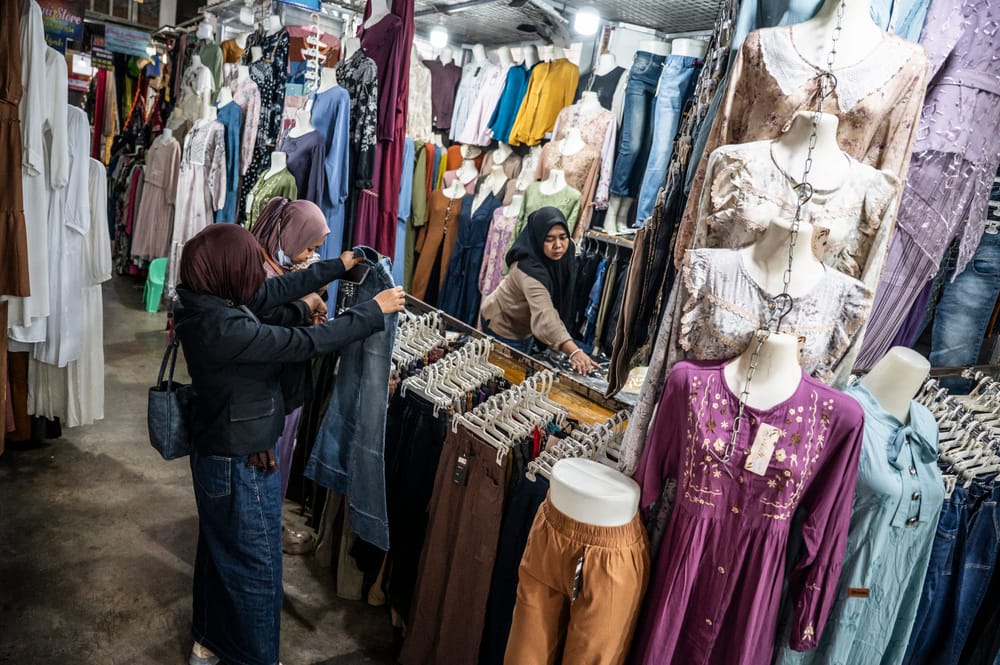Plaza Semanggi is now sparkling again. From being deserted like a graveyard to being crowded with visitors. Yes, there has been a change in the iconic shopping center at the Semanggi interchange, Jakarta, because it has transformed and changed its name to Lippo Mall Nusantara.
This change is not only limited to the name, but also the concept. From the results of the SUAR Team's investigation, Lippo Mall Nusantara is now enlivened with interesting food courts, especially for office workers in the Sudirman and Gatot Subroto areas.
The food court area on the LG floor is the most crowded location. The mall now also has the facility of providing plenty of seating in the lobby, such as dozens of long tables, for visitors to relax and unwind.
The area has a capacity of more than 1,000 seats and serves more than 200 Indonesian specialties from more than 200 UMKM.
The ambience of Nusantara mall is also enhanced by decorative elements such as fountains and trees. In addition, the Indonesian Struggle Museum - the only museum in the shopping center - complements the ambience by displaying biographies of Indonesian heroes to create a comfortable and culturally rich experience.
This concept turned out to be successful, as evidenced by the large number of visitors who came. Since its grand opening in February, the mall has come back to life from its long slumber due to lack of visitors,
According to Intan Maulidia Putri, 31, an employee of Lontong and Nasi Kari Legenda Medan merchant, food and beverage (FnB) outlets dominate, and visitors are increasing.
"The number of visitors for now, yes, during working hours. Office breaks usually start at 12.00 until 16.00," he told SUAR when met at Lippo Mall Nusantara, (6/8/2025).
The variety of menus and attractive decorations invite mall visitors to spend time and gather with family or relatives.
Intan also added that the sales of her tenants have increased from the initial launching until now. According to her, the variety of menus and attractive decorations invite mall visitors to spend time and gather with family or relatives.

Not only Lippo Mall Nusantara, the condition of Plaza Blok M is also not much different. Since the construction of the mass rapid transit (MRT), the mall opposite the Blok M terminal has also been crowded with visitors again. All tenants seem to fill the mall which is the pride of the people of Jaksel.
"Access is very easy, especially by MRT. Visitors can get off directly at Blok M MRT Station," said one visitor, Salsabila Cynailla, 20.
Besides being easily accessible by public transportation, the Blok M area itself is a lively area and has many places of interest, making this mall always lively and a popular destination.
"Access is very easy, especially by MRT. Visitors can get off directly at Blok M MRT Station," said one visitor, Salsabila Cynailla.
Cynailla said she likes coming to Blok M because it is a center for snacks and fashion. This time, she and four of her friends came to take selfies at a photobooth booth that offered a variety of unique costumes and accessories ranging from glasses to hats.
"Initially, I went to Plaza Blok M because it was close and there were lots of snacks. I used to spend time here with my family, now I go with friends," he said.
Apart from these two malls, several other malls that have been transformed include ITC Fatmawati, Ambassador Mall, and Sarinah.
Mall visits, for some, are now often more about fun and socializing than just shopping, a change that reflects how malls in Indonesia are starting to transform into hangout and entertainment venues.
From shopping to hangout
This change in function has made malls in Indonesia move in a broader direction from just a shopping center to a social connection hub. Movie theaters, thematic restaurants, live music, and sports arenas are the main reasons why people come. Shopping is often done afterward, sometimes even moving online.
"The tendency is to go to the mall either to watch movies or eat, gather with family or friends," said Alphonzus Widjaja, Chairman of the Indonesian Shopping Center Management Association (APPBI), in Jakarta, Wednesday (6/8).
"The tendency is to go to the mall to either watch a movie or eat, gather with family or friends," said Alphonzus Widjaja, Chairman of the Indonesian Shopping Center Management Association (APPBI).
Despite the growing trend of online shopping, Alphonzus believes the prospects for malls in Indonesia are still bright. The reason is simple: the ratio of shopping centers per capita in Indonesia is the lowest in ASEAN.
This means, he said, that the room for growth is still large. But, he admits, department stores and hypermarkets are under pressure. Many are closing because they are losing out to new, more efficient shopping formats.
Amid the onslaught of foreign brands, Alphonzus emphasized the importance of supporting local products. "Foreign brands are welcome, but support local products with facilities, incentives, and conveniences," he said.
Coffee shops and restaurants have mushroomed in malls, replacing some of the conventional retail space. Before the pandemic, the food & beverage (F&B) portion in malls was only 10%-20%. Now, Alphonzus said, the figure has jumped to 30%-40%.
"But it can't dominate," he adds. Other innovations such as Padel courts, art showrooms, and children's play zones are also new magnets. All of these accommodate the trend that consumers come to the mall to "experience", not just bring home shopping bags.
Post-pandemic behavior change
Heri Andreas, an expert from Indef, said that this change in behavior is in stark contrast to the pre-pandemic era.
"Before the pandemic, we used to go everywhere. Besides eating at restaurants, we also shopped. But after Covid-19, we enjoy shopping online. Eh, it turns out that online shopping is more exciting than direct shopping. Well, that's what is addicted until now," he told SUAR when met at the Indef Office (06/08).
Consumers are now smarter about comparing prices. The same item in a department store can be much more expensive than in a marketplace. Choices are also abundant, without having to leave the house. "It's better to buy online," says Heri.
This pattern forces retailers to no longer rely solely on physical visits. According to Heri, many brands are now downsizing their offline stores to just display space, and pushing the final transaction to happen on online platforms.
However, malls still have an advantage that mobile screens can't replicate: atmosphere. After months of isolation at home, people long for social spaces. "We also have to see that people's behavior is that they are looking for a cozy place. To hang out, socialize, hang out," Heri explained.
Malls still have an advantage that mobile screens can't replicate: ambience.
This phenomenon has also led to the emergence of culinary centers outside malls, such as open-air food courts that are always crowded during after-work hours or on weekends. Heri sees this trend as a form of adaptation.
"Now there are many spaces in one area that contain all food. It's full all the time. After work, hanging out, gathering ... so there are many like that now," he said.
An omni-channel strategy is key. Malls are no longer hostile to e-commerce platforms, but instead use them as an extension of the storefront. Consumers can see the goods in the physical store, then decide to buy them online.
"Hopefully, with programs like this we can provide an attraction for consumers to shop, both in malls and online," said Heri.






